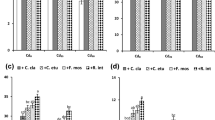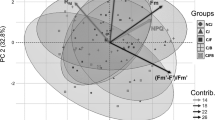Abstract
This study identifies the potential use of the combined application of hardwood-derived biochar (BC) and phytohormone-producing endophytes for enhancing crop production under heavy metal stress. For this purpose, the endophyte Galactomyces geotrichum WLL1 was isolated from Trapa japonica inhabiting a Korean river whose rainfall catchment area included an abandoned zinc mine. Pyrolyzed BC derived from pine hardwoods was obtained commercially. Under growth chamber conditions, the combined or individual application of G. geotrichum WLL1 and BC (15 % w/w) significantly improved soybean growth with or without excess Zn (5,253.6 mg kg−1). The beneficial effect of treatments was observed in the low uptake of Zn by different plant tissues and its immobilization in the soil. Biochar and G. geotrichum WLL1 shared their beneficial properties synergistically and improved plant growth characteristics with or without Zn heavy metal stress (HMS). Further, intensive root colonization of G. geotrichum WLL1 in the presence of BC was observed irrespective of HMS. Most interestingly, BC and G. geotrichum WLL1 had a priming effect by inducing systemic resistance in soybeans as revealed by significantly large amounts of jasmonic acid. These properties of BC could be exploited under abiotic and biotic stress. Here, for the first time, the combined application of hardwood-derived BC and phytohormone-producing endophytes is recommended for environmentally friendly and cost-effective crop production under HMS.



Similar content being viewed by others
References
Ahmad M, Lee SS, Yang JE, Ro H-M, Lee YH, Ok YS (2012) Effects of soil dilution and amendments (mussel shell, cow bone, and biochar) on Pb availability and phytotoxicity in military shooting range soil. Ecotoxicol Environ Saf 79:225–231
Alburquerque JA, Calero JM, Barrón V, Torrent J, del Campillo MC, Gallardo A, Villar R (2014) Effects of biochars produced from different feedstocks on soil properties and sunflower growth. J Plant Nutr Soil Sci 177:16–25
Arnold AE, Henk DA, Eells RL, Lutzoni F, Vilgalys R (2007) Diversity and phylogenetic affinities of foliar fungal endophytes in loblolly pine inferred by culturing and environmental PCR. Mycologia 99:185–206
Bellaloui N (2012) Soybean seed phenol, lignin, and isoflavones and sugars composition altered by foliar boron application in soybean under water stress. Food Nutri Sci 3:3579–3590
Bellaloui N, Hu Y, Mengistu A, Kassem MA, Abel CA (2013) Effects of foliar boron application on seed composition, cell wall boron, and seed δ15N and δ13C isotopes in water-stressed soybean plants. Front Plant Sci 4:270
Bolan NS, Naidu R, Syers JK, Tillman RW (1999) Surface charge and solute interactions in soils. Adv Agron 67:88–141
Bridge G (2004) Contested terrain: mining and the environment. Ann Rev Environ Res 29:205–259
Buss W, Kammann C, Koyro HW (2011) Biochar reduces copper toxicity in Chenopodium quinoa Willd. in a sandy soil. J Environ Qual 40:1–9
Chan KY, Xu Z (2009) Biochar: nutrient properties and their enhancement. In: Lehmann J, Joseph S (eds) Biochar for environmental management: science and technology. Earthscan, London, pp 67–84
Chaouia A, Mazhoudia S, Ghorbalb MH, Ferjania EE (1997) Cadmium and zinc induction of lipid peroxidation and effects on antioxidant enzyme activities in bean (Phaseolus vulgaris L.). Plant Sci 127:139–147
Cui S, Zhou Q, Chao L (2007) Potential hyper-accumulation of Pb, Zn, Cu and Cd in endurant plants distributed in an old smeltery, northeast China. Environ Geol 51:1043–1048
Deng Z, Cao L, Huang H, Jiang X, Wang W, Shi Y, Zhang R (2011) Characterization of Cd- and Pb-resistant fungal endophyte Mucor sp. CBRF59 isolated from rapes (Brassica chinensis) in a metal-contaminated soil. J Hazard Mater 185:717–724
Elad Y, Cytryn E, Harel YM, Lew B, Graber ER (2011) The biochar effect: plant resistance to biotic stresses. Phytopathol Mediterr 50:335–349
Farrell M, Macdonald LM, Butler G, Chirino-Valle I, Condron LM (2014) Biochar and fertiliser applications influence phosphorus fractionation and wheat yield. Biol Fertil Soils 50:169–178
Förstner U (1995) Land contamination by metals: global scope and magnitude of problem. In: Allen HE, Huang C-P, Bailey GW, Bowers AR (eds) Metal speciation and contamination of soil. Lewis Publ, Boca Raton, pp 1–33
Gapper C, Dolan L (2006) Control of plant development by reactive oxygen species. Plant Physiol 141:341–345
Glaser B, Lehmann J, Zech W (2002) Ameliorating physical and chemical properties of highly weathered soils in the tropics with charcoal—a review. Biol Ferti Soils 35:219–230
Harel YM, Elad Y, Rav-David D, Borenstein M, Shulchani R, Lew B, Graber ER (2012) Biochar mediates systemic response of strawberry to foliar fungal pathogens. Plant Soil 357:245–257
Hong SH, Lee YH, Na CS, Kim DY, Kim JG, Kang BH, Shim SI (2010) Analysis of weed vegetation in vicinity of abandoned mines. Kor J Weed Sci 30:17–24
Jones DL, Rousk J, Edwards-Jones G, DeLuca TH, Murphy DV (2012) Biochar-mediated changes in soil quality and plant growth in a three year field trial. Soil Biol Biochem 45:113–124
Khan AL, Lee IJ (2013) Endophytic Penicillium funiculosum LHL06 secretes gibberellin that reprograms Glycine max L. growth during copper stress. BMC Plant Biol 13:86
Khan AL, Hamayun M, Ahmad N, Waqas M, Kang SM, Kim YH, Lee IJ (2011) Exophiala sp. LHL08 reprograms Cucumis sativus to higher growth under abiotic stresses. Physiol Plant 143:329–343
Khan AL, Waqas M, Hussain J, Al-Harrasi A, Lee IJ (2013) Fungal endophyte Penicillium janthinellum LK5 can reduce cadmium toxicity in Solanum lycopersicum (Sitiens and Rhe). Biol Fertil Soils 50:75–85
Kim B, McBride MB (2009) Phytotoxic effects of Cu and Zn on soybeans grown in field-aged soils: their additive and interactive actions. J Environ Qual 38:2253–2259
Kim TS, Choi SI, Yang JK, Lee IS, Bae B (2010) A study on the application of enhanced phytoremediation with plant growth promoting rhizobacteria for Zn contaminated rice paddy soil. J Soil Groundw Environ 15:15–26
Kim EH, Kim SL, Kim SH, Chung IM (2012a) Comparison of isoflavones and anthocyanins in soybean [Glycine max (L.) Merrill] seeds of different planting dates. J Agric Food Chem 60:10196–10202
Kim EH, Ro HM, Kim SL, Kim HS, Chung IM (2012b) Analysis of isoflavone, phenolic, soyasapogenol, and tocopherol compounds in soybean [Glycine max (L.) Merrill] germplasms of different seed weights and origins. J Agric Food Chem 60:6045–6055
Kim YH, Khan AL, Waqas M, Shim JK, Kim DH, Lee KY, Lee IJ (2014) Silicon application to rice root zone influenced the phytohormonal and antioxidants responses under salinity stress. J Plant Growth Regul 33:137–149
Lehmann J (2007) A handful of carbon. Nature 447:143–144
Li MS, Luo YP, Su ZY (2007) Heavy metal concentrations in soils and plant accumulation in a restored manganese mineland in Guangxi, South China. Environ Pollut 147:168–175
Li HY, Wei DQ, Shen M, Zhou ZP (2012) Endophytes and their role in phytoremediation. Fungal Divers 54:11–18
Likar M, Regvar M (2013) Isolates of dark septate endophytes reduce metal uptake and improve physiology of Salix caprea L. Plant Soil 370:593–604
Liu Z, Zhang FS (2009) Removal of lead from water using biochars prepared from hydrothermal liquefaction of biomass. J Hazard Mater 167:933–939
Maksymiec W, Krupa Z (2002) Jasmonic acid and heavy metals in Arabidopsis plants—a similar physiological response to both stressors? J Plant Physiol 159:509–515
Maksymiec W, Wójcik M, Krupa Z (2007) Variation in oxidative stress and photochemical activity in Arabidopsis thaliana leaves subjected to cadmium and excess copper in the presence or absence of jasmonate and ascorbate. Chemosphere 66:421–427
McCloud ES, Baldwin IT (1997) Herbivory and caterpillar regurgitants amplify the wound induced increases in jasmonic acid but not nicotine in Nicotiana sylvestris. Planta 203:430–435
Park JH, Choppala GK, Bolan NS, Chung JW, Chuasavathi T (2011) Biochar reduces the bioavailability and phytotoxicity of heavy metals. Plant Soil 348:439–451
Redman RS, Kim YO, Woodward CJDA, Greer C, Espino L, Sharon LD, Rodriguez RJ (2011) Increased fitness of rice plants to abiotic stress via habitat adapted symbiosis: a strategy for mitigating impacts of climate change. PLoS ONE 6:e14823. doi:10.1371/journal.pone.0014823
Rondon MA, Lehmann J, Ramirez J, Hurtado M (2007) Biological nitrogen fixation by common beans (Phaseolus vulgaris L.) increases with bio-char additions. Biol Fertil Soils 43:699–708
Schulz B, Boyle C (2005) The endophytic continuum. Mycol Res 109:661–686
Scott B, Eaton CJ (2008) Role of reactive oxygen species in fungal cellular differentiations. Curr Opin Microbiol 11:488–493
Silar P (2005) Peroxide accumulation and cell death in filamentous fungi induced by contact with a contestant. Mycol Res 109:137–149
Solaiman ZM, Murphy DV, Abbott LK (2012) Biochars influence seed germination and early growth of seedlings. Plant Soil 353:273–287
Soleimani M, Hajabbasi MA, Afyuni M, Mirlohi A, Borggaard OK, Holm PE (2010) Effect of endophytic fungi on cadmium tolerance and bioaccumulation by Festuca arundinacea and Festuca pratensis. Int J Phytoremediation 12:535–549
Strobel G, Daisy B, Castillo U, Harper J (2004) Natural products from endophytic microorganisms. J Nat Prod 67:257–268
Tamura K, Stecher G, Peterson D, Filipski A, Kumar S (2013) MEGA6: molecular evolutionary genetics analysis version 6.0. Mol Biol Evol 30:2725–2729
Tanaka A, Christensen MJ, Takemoto D, Park P, Scott B (2006) Reactive oxygen species play a role in regulating a fungus–perennial ryegrass mutualistic interaction. Plant Cell 18:1052–1066
Torres MA (2010) ROS in biotic interactions. Physiol Plant 138:414–429
Tsonev T, Lidon FJC (2012) Zinc in plants—an overview. Emir J Food Agric 24:322–333
Waller F, Achatz B, Baltruschat H, Fodor J, Becker K, Fischer M, Heier T, Huckelhoven R, Neumann C, Wettstein D, Franken P, Kogel KH (2005) The endophytic fungus Piriformis indica reprograms barley to salt-stress tolerance, disease resistance, and higher yield. PNAS 102:13386–13391
Waqas M, Khan AL, Kamran M, Hamayun M, Kang S-M, Kim Y-H, Lee I-J (2012) Endophytic fungi produce gibberellins and indoleacetic acid and promotes host-plant growth during stress. Molecules 17:10754–10773
Waqas M, Khan AL, Ali L, Kang S-M, Kim Y-H, Lee I-J (2013) Seed germination-influencing bioactive secondary metabolites secreted by the endophyte Cladosporium cladosporioides LWL5. Molecules 18:15519–15530
Waqas M, Khan AL, Lee I-J (2014) Bioactive chemical constituents produced by endophytes and effects on rice plant growth. J Plant Interact 9:478–487
Warnock DD, Mummey DL, McBride B, Major J, Lehmann J, Rillig MC (2010) Influences of non-herbaceous biochar on arbuscular mycorrhizal fungal abundances in roots and soils: results from growth-chamber and field experiments. Appl Soil Ecol 46:450–456
White JF Jr, Torres MS (2010) Is plant endophyte-mediated defensive mutualism the result of oxidative stress protection? Physiol Plant 138:440–446
Woolf D, Amonette JE, Street-Perrott FA, Lehmann J, Joseph S (2010) Sustainable biochar to mitigate global climate change. Nat Commun 1:1–9
Xu B, Chang SKC (2008) Antioxidant capacity of seed coat, dehulled bran, and whole black soybeans in relation to their distributions of total phenolics, phenolic acids, anthocyanins, and isoflavones. J Agric Food Chem 56:8365–8373
Yin D, Jun M, Zheng G, Zhong X, Yu L, Gao J, Chen W (2012) Effects of biochar on acid black soil nutrient, soybean root and yield. Adv Mater Res 524–527:2278–2289
Yoon J, Cao X, Zhou Q, Ma LQ (2006) Accumulation of Pb, Cu, and Zn in native plants growing on a contaminated Florida site. Sci Total Environ 368:456–464
Zhang A, Bian R, Pan G, Cui L, Hussain Q, Li L, Zheng J, Zheng J, Zhang X, Han X, Yu X (2012) Effects of biochar amendment on soil quality, crop yield and greenhouse gas emission in a Chinese rice paddy: a field study of 2 consecutive rice growing cycles. Field Crop Res 127:153–160
Zhang X, Wang H, He L, Lu K, Sarmah A, Li J, Bolan NS, Pei J, Huang H (2013) Using biochar for remediation of soils contaminated with heavy metals and organic pollutants. Environ Sci Pollut Res 20:8472–8483
Acknowledgments
The present research work was funded by the Eco-Innovation Project, Korean Government’s R&D program on Environmental Technology and Development, Republic of Korea.
Author information
Authors and Affiliations
Corresponding author
Rights and permissions
About this article
Cite this article
Waqas, M., Khan, A.L., Kang, SM. et al. Phytohormone-producing fungal endophytes and hardwood-derived biochar interact to ameliorate heavy metal stress in soybeans. Biol Fertil Soils 50, 1155–1167 (2014). https://doi.org/10.1007/s00374-014-0937-4
Received:
Revised:
Accepted:
Published:
Issue Date:
DOI: https://doi.org/10.1007/s00374-014-0937-4




